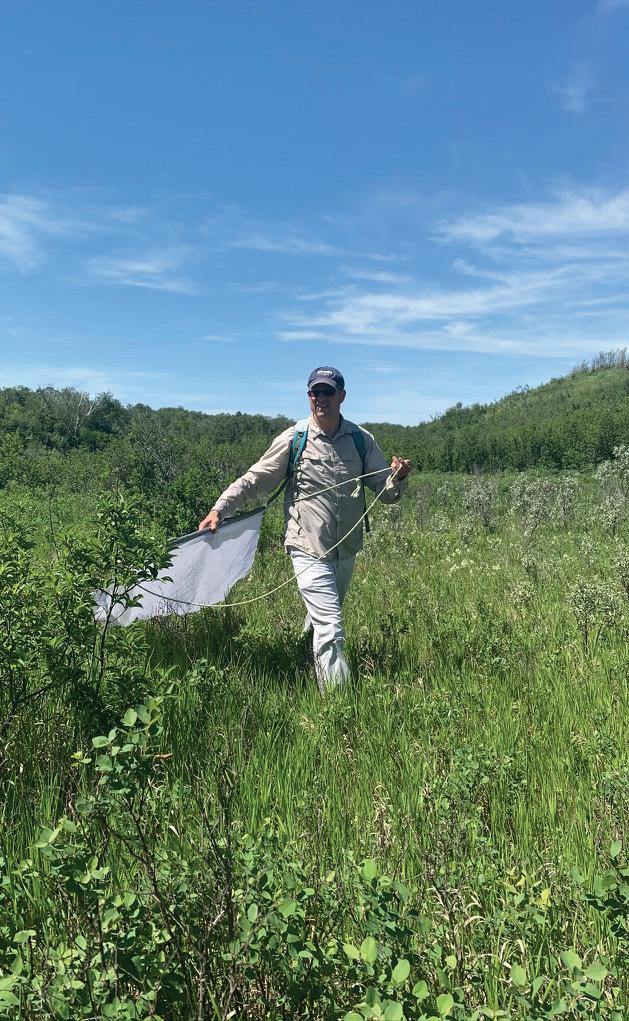
7 minute read
Tracking ticks with technology
“Flying Tick’ ILLUSTRATION: STEVE SARVAJC
TICK INVASION
Advertisement

As hitchhiking ticks make the warming praries their new home—a new app is soon to reach Alberta, during provincial submit-a-tick freeze.
ANGELA LACKEY
alackey@cjournal
CHRISTIAN KINDRACHUK
ckindrachuk@cjournal
The pandemic has led more Albertans to enjoy the great outdoors in record numbers while simultaneously shutting down Alberta’s submit-a-tick program.
This is unfortunate timing because the Lyme diseasecarrying black-legged tick is a growing problem in Canada, even in places that would traditionally be considered uninhabitable such as the Prairies. But the good news is a new tick tracking service, eTick, will be launching in Alberta in late spring.
ALBERTA SUBMIT-A-TICK
Over the past three years, Alberta monitored ticks through the submit-a-tick program, where ticks could be mailed in or dropped off at the Alberta Health Services Environmental Health Offi ce for testing and identifi cation.
Since starting, it had seen increased submissions of ticks to be tested. Last year, the number of ticks increased to 2,870 from the 960 sent in 2013.
Of those, 63 were capable of carrying Lyme disease and three tested positive for the bacteria.
“All available resources and staff at Alberta Health are helping to manage and monitor the pandemic, and the tick program was paused,” read a statement by Zoë Cooper, a spokesperson for Alberta Health.
Cooper’s statement notes that Albertans are still able to physically submit a tick to their health care provider for identifi cation and assessment in the meantime.
GOING OUTSIDE
But that process can sometimes take months to complete. And that delay will take place against the backdrop of growing numbers of campers and hikers in the spring.
A statement by Alberta Parks read, “last year was the busiest camping season in Alberta to date, and we’re expecting similar numbers in 2021.”
Dr. Maarten Voordouw, an assistant professor of veterinary microbiology at the University of Saskatchewan with 10 years of tick and tick-borne disease research under his belt, said if more people are out camping and hiking, they’re more likely to encounter ticks.
TICKS IN ALBERTA
One place you’re likely to stumble upon ticks in Alberta is in the Edmonton River Valley, where it’s warm and relatively humid, according to Janet Sperling, who is involved with the Canadian Lyme Disease Foundation.
And according to an interactive map from the Government of Alberta, several ticks in the Edmonton River Valley were submitted in 2019, with one testing positive for the Lyme virus.
But the problem is we can’t rely on these numbers because we don’t really know the tick populations or how many Albertans have been bitten.
“We know a lot of people get a tick bite, but we don’t know exactly how many people because nobody’s keeping track,” Sperling said.
Humans can transmit Lyme disease through Tick bites. Still, it can take up to 48-hours or longer until the bacteria can be transmitted from the tick to a person, according to Dr. George Chaconas, a network member of the Canadian Lyme disease research network.
Chaconas notes ways to prevent getting bitten from ticks like wearing light clothes to draw ticks out, tucking pant legs into socks so they can’t get onto your legs, as well as doing a tick check as a way to take preventative measures from having the tick on someone for long periods.
And, just because black-legged ticks, the species of tick capable of carrying and transmitting Lyme and other diseases to humans, have not been shown to reproduce in the Prairies, doesn’t mean they’re not here.w
“We’re still trying to determine in Saskatchewan, and I think the same is true for Alberta, whether there are established black-legged tick populations,” Voordouw said.
THEY’RE COMING BY ANIMALS
There are a few theories to explain the tick population in Alberta. Studies have been conducted that show ticks travelling to Canada and the Prairies on migratory hosts.
Canada’s Public Health Agency reported somewhere between 50 million to 175 million hitch-hiking blacklegged ticks landing in Canada from migrating birds flying north each year.
Black-legged ticks live approximately two years, so a week-long flight and a meal—is no big deal.
“The ticks are hearty, and they can survive. And then they’ll quest the following year looking for blood.
Besides migratory birds, Sperling said deer might be one reason black-legged ticks are popping up more in Alberta.
“The deer could start off in, say Winnipeg, and then as they walk across through Saskatchewan, they’re coming through the river valley,” Sperling said.
Ticks are also showing up in new Canadian locations, as they warm due to climate change.
According to Dr. George Chaconas, a member of the Canadian Lyme disease research network, “As our winters are getting less harsh there’s no question there that it’s easier for the tick to set up.”
“I think it’s just a matter of time until the moister areas in the province begin having stable populations of infected ticks. It can certainly happen,” Sperling said.
ABOUT ETICK
Given the changing locations and populations of these potential eight-legged disease-carriers, an effective, active tracking method is important.
And that’s where the four-year-old Quebec-born federally-funded program called eTick comes in, allowing citizens in partnered provinces to snap photos of ticks they found.
This differs from traditional mail-in methods and Alberta’s submit-a-tick program, where ticks must be physically submitted in order to be identified.
Photo of Dr. Maarten Voordouw doing active surveillance in Saskatchewan, a process of dragging a rope with a white cloth on a dowel at the end. The fabric mimics an animal moving through the vegetation, causing the ticks
to grapple onto the cloth with their hook-like feet. PHOTO: DR. MAARTEN VOORDOUW

Citizens can send images through a handy smartphone app or online and receive species identification within 24-hours, even over weekends. This is a far cry from the weeks or months worried Canadians would wait long periods after being nibbled on by an unidentified insect.
Although eTick does not test for diseases, like Lyme, the vast majority of ticks submitted are not species which are capable of transmitting Lyme and other diseases, eTick efficiently updates the user with either information that quickly sets their mind at ease.
If it is a black-legged tick, or is suspected to be, the user will be given direction on how they should follow up, enabling them to be informed and act fast.
Dr. Pierre Chuard, a biologist and adjunct professor at Bishop’s University in Sherbrooke, Quebec, and project manager of eTick, said the program’s main benefits are tick awareness, passive surveillance of tick presence, a triaging effect for the local health care system, and near-immediate results to the user.
PASSIVE SURVEILLANCE
Although this new tool makes submissions and responses to and from the user easier than it’s ever been before, there are a few challenges with relying solely people submitting ticks they found to determine the prevalence of those insects
This passive surveillance is different from active surveillance—a more hands-on approach, Chaconas said. Active surveillance gives a better understanding to tick populations as researchers would head out to where ticks are and gather information, instead of relying on passive surveillance from the general public.
With a passive method, you will get more submissions at times and in places where people are. Higher numbers may appear in provinces with higher human populations—obviously, this does not entirely reflect the tick population.
With eTick being a novel, new service it’s likely that will also cause an influx in submissions. So researchers such as Chuard are looking for proportions of ticks growing or moving to new locations, not the density.
WHY IT’S STILL A GOOD CHOICE
It’s also important to note that, right now, the app only tracks ticks, not Lyme disease. However, this gives researchers a fast and detailed view of new or changing proportions of black-legged ticks, identifying candidates for active surveillance.
Voordouw has used coordinates provided through eTick to conduct active surveillance of black-legged ticks in Saskatchewan.
He’ll go into the field with a rope tied to a dowel that has a large white cloth draped off of it. The dragging fabric mimics an animal moving through the vegetation, causing the ticks to grapple onto the fabric with their hook-like feet. The captured ticks provide researchers information about species, disease, density, reproduction and more.
ETICK LAUNCH
With the increase in campers in Alberta’s parks, and the absence of the submit-a-tick program, there is a need for eTick, although it’s not here quite yet.
But, understanding the pressure COVID-19 puts on the healthcare system, Voordouw said he’s grateful for programs like eTick in Saskatchewan, where it launched just under a year ago.
Cooper writes, eTick will be launched later this spring and all updates to the tick surveillance program are available on the Alberta Health website.
> Janet Sperling
Photo of Diariata N’Diaye. PHOTO: @ DIARIATANDIAYE
For those wondering what these creepy-crawlies look like, black-legged ticks have black legs (no kidding), the females with a distinguishing rust brown and black dorsal shield, the males are mostly black with a creamy coloured outline. As with all ticks, they have eight legs past the larvae stage, a small rectangular-shaped head atop an oblong dorsal shield. Once engorged (full of blood), they look more like a small jelly-belly.










